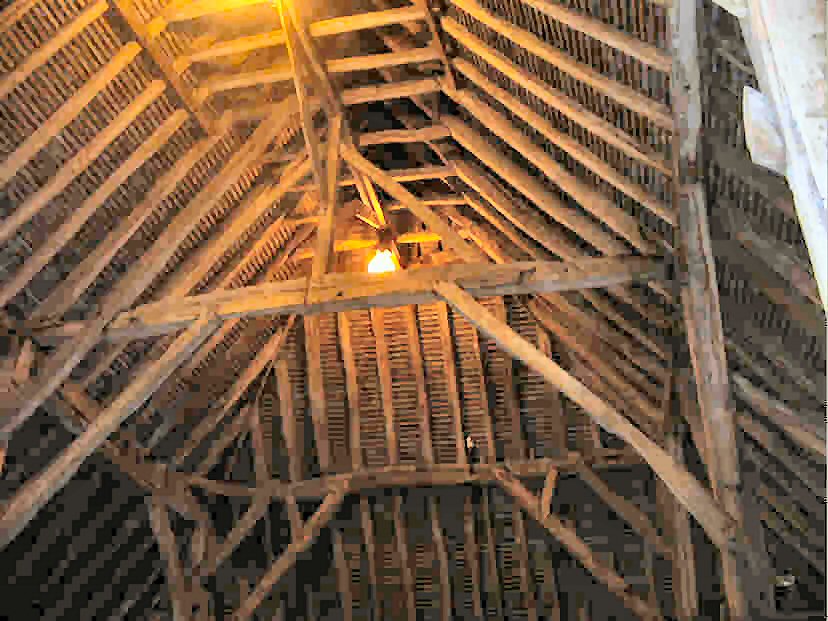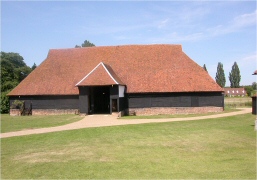

The notice in front of the Knights Templar scene says:
"The Templar knight stands outside a church inside which a man is being received into the Order. The man is interrogated about his past life, and then, kneeling and holding the Bible, takes a vow of poverty, chastity and obedience. Rumours about the rites performed at Templar initiation ceremonies figured amongst the charges brought against the Templars at the time of the suppression in 1312."
Timber Beams


More pictures of the Barns


The Preceptory of Cressing Temple was probably one of the earliest in England. The manor with its church was granted to the Order by Queen Matilda by a charter dated at Evreux in 1136 and later confirmed by King Stephen. Cressing and its environs was a very rich agricultural area, with wheat, corn, barley and oats grown there.
"Here in this prosperous agricultural area, the Templars, ever shrewd stewards of their resources, owned two great barns: what is nowadays called the Barley Barn was built circa 1200-1220 and a larger barn, now designated the Wheat Barn, circa 1260…the barns were not demolished in a later age, but were kept in use and repair. In 1987, the whole complex was acquired by Essex County Council (with help from English Heritage and the National Heritage Memorial Fund)." (1) These well-preserved wooden barns are still standing today.
In addition to all of these important features, the Preceptory at Cressing Temple also had five corn mills. Mr. George Tull, in his informative book 'Traces of the Templars' elaborates:
The Preceptory was seemingly well ordered, including in its buildings, a hall house with chamber, pantry, buttery, kitchen, larder, bakehouse/brewhouse and dairy. There was also a cider mill, smithy and a store containing building materials. The farm stock comprised cattle, pigs, sheep, geese, chickens and peafowl. Ponds or moats would have provided fish and there would have been a dovecote…There are Templars' Woods at Cressing, but no visible remains of the house, outbuildings, or chapel, though the position of the latter is known. " (2)
Revenue raised from large, prosperous Templar farms like this complex at Cressing, made it possible for the Knights Templar to fight for the return of the Holy Land to Christianity.
The Templars maintained three chaplains at Cressing, for services and to pray for departed benefactors. The chapel was dedicated to St. Mary and was still extant in 1626.
"Excavations on the site so far have revealed a shallow fishpond, probably constructed in the twelfth century. Slight traces of a ditch mark the extent of the site. Excavations are continuing…." (3)
Later, in 1153-54, a market at Witham was added to the lands belonging to Cressing. "This market, which had been established by Henry I, was one of the first in Essex after the Norman conquest. Cressing ultimately became the centre of an agricultural estate of some 2000 acres, including the five mills, two markets and an annual three days fair." (4)
Cressing Temple is unique, especially as nowhere else in England can be found such complete farm buildings, such as the granaries, that date from medieval times. The great barns, the Barley Barn and the Wheat Barn, are also important sites in their own right regarding sites in medieval England.
So, there is much to see, even today, at Cressing Temple from earlier times, unlike some of the other Templar sites.
References:
- Tull, George, Traces of the Templars, p66
- ibid
- ibid
- ibid
Visit the Cressing Temple web site.